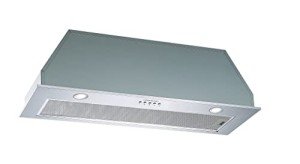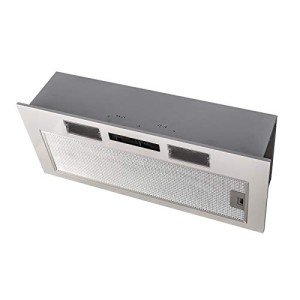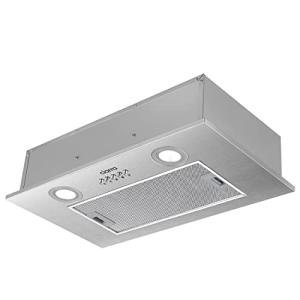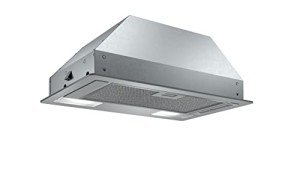The kitchen, often considered the heart of the home, is a space for culinary creativity and convivial gatherings. However, the joys of cooking can sometimes be marred by unwanted odors, grease, and steam. This is where a cooker hood becomes an indispensable appliance, ensuring a clean, fresh, and comfortable cooking environment. Among the various types available, the 90cm stainless steel integrated cooker hood stands out as a sophisticated and efficient solution, seamlessly blending into modern kitchen designs while delivering powerful performance.
This guide delves into the world of 90cm stainless steel integrated cooker hoods, exploring their features, benefits, and key considerations for choosing the right model for your kitchen. We will examine why this particular type is a popular choice for homeowners seeking a balance of functionality, aesthetics, and durability.
What is an Integrated Cooker Hood?
An integrated cooker hood, also known as a built-in or concealed cooker hood, is designed to be discreetly installed within kitchen cabinetry. Unlike chimney hoods or island hoods that are prominent features, integrated hoods are hidden from view when not in use, contributing to a cleaner, more streamlined kitchen aesthetic. They are typically installed above the hob, within a kitchen cabinet or custom-built housing. When activated, a section of the cabinet might slide out or a panel might open to reveal the extraction system.
Integrated cooker hoods prioritize subtlety and space-saving design, making them ideal for kitchens where visual harmony and maximizing cabinet space are important. They offer an effective way to manage cooking fumes without dominating the kitchen's visual landscape.
Why Choose a 90cm Stainless Steel Model?
The combination of a 90cm width and stainless steel construction in an integrated cooker hood offers a multitude of advantages:
1. Optimal Coverage for Larger Hobs:
90cm is a popular width for cooker hoods as it perfectly complements standard 90cm wide hobs and even provides excellent coverage for slightly smaller 75cm or 80cm hobs. This wider design ensures that fumes, smoke, and grease produced across all burners are effectively captured, preventing them from spreading throughout the kitchen. This is particularly crucial for larger families or enthusiastic cooks who frequently use multiple hob burners simultaneously.
2. Powerful Extraction Capabilities:
Due to their size, 90cm cooker hoods often house more powerful motors and larger filters. This translates to enhanced extraction rates (measured in cubic meters per hour - m³/h), efficiently removing cooking odors, grease, and steam from the air. A more powerful extraction system contributes to better air quality in the kitchen, reducing the build-up of grease on surfaces and minimizing lingering cooking smells.
3. Durability and Longevity of Stainless Steel:
Stainless steel is a highly favored material in kitchen appliances due to its exceptional durability and resistance to corrosion, staining, and heat. A stainless steel cooker hood can withstand the rigors of daily cooking and is easy to clean, maintaining its sleek appearance for years to come. Its robust nature ensures the hood remains a reliable and long-lasting kitchen fixture.
4. Modern and Sleek Aesthetics:
Stainless steel is synonymous with modern kitchen design. Its clean lines and neutral metallic finish seamlessly integrate into a wide range of kitchen styles, from contemporary to minimalist and even industrial-inspired spaces. While the hood itself is integrated and hidden, the stainless steel components, when visible, add a touch of sophistication and professionalism to the kitchen.
5. Enhanced Lighting:
Many 90cm stainless steel integrated cooker hoods come equipped with built-in LED lighting. Positioned directly above the hob, this integrated lighting provides focused illumination for the cooking area. LED lights are energy-efficient and long-lasting, enhancing visibility while cooking and adding to the overall functionality of the appliance.
6. Increased Property Value:
Investing in quality kitchen appliances like a 90cm stainless steel integrated cooker hood can enhance the overall value of your home. It demonstrates a commitment to quality and modern amenities, making your kitchen more appealing to potential buyers.
Key Features to Consider in a 90cm Stainless Steel Integrated Cooker Hood
When choosing a 90cm stainless steel integrated cooker hood, several features should be carefully considered to ensure it meets your specific needs and kitchen requirements.
Table: Key Features Comparison
| Feature | Description | Importance Level | Considerations |
|---|---|---|---|
| Extraction Rate (m³/h) | Measures the volume of air the hood can extract per hour. | High | Match to kitchen size and cooking habits. Higher rates for larger kitchens and frequent cooking. |
| Noise Level (dB) | Sound level produced by the hood during operation. | Medium | Opt for quieter models, especially if the kitchen is open-plan or noise sensitivity is a concern. |
| Fan Speeds | Number of speed settings for the extractor fan. | Medium | Allows adjusting extraction power based on cooking intensity. |
| Filtration System | Type of filters used to trap grease and odors. | High | Look for washable grease filters and options for carbon filters for recirculating models. |
| Lighting | Type and intensity of built-in lighting. | Medium | LED lighting recommended for energy efficiency and longevity. |
| Controls | Type of controls – push buttons, touch controls, or remote control. | Low to Medium | Personal preference and ease of use. Touch controls offer a sleek look. |
| Installation Type | Ducting (extraction) or Recirculating. | High | Ducting is generally more effective but requires external venting. Recirculating is easier to install. |
| Energy Efficiency Rating | Indicates the hood's energy consumption. | Medium | Look for higher energy ratings to save on electricity bills. |
List: Important Questions to Ask Before Purchasing:
- What is the size of my hob and kitchen space? This will help determine the appropriate extraction rate needed.
- Do I have external venting available for ducting? If not, a recirculating model with carbon filters will be necessary.
- How often and what type of cooking do I typically do? Frequent and greasy cooking will require a more powerful and efficient hood.
- What is my budget? Prices vary based on features and brand reputation.
- What aesthetic style am I aiming for in my kitchen? Ensure the hood's design complements your kitchen’s overall look.
- What are the warranty and after-sales service offered by the manufacturer?
Installation and Maintenance
Installation:
Integrated cooker hoods are typically installed by a qualified professional, particularly if ducting is required. The installation process involves:
- Preparing the Cabinetry: Ensuring the cabinet or housing above the hob is appropriately sized and prepared to accommodate the hood.
- Mounting the Hood: Securely fixing the hood within the cabinet according to the manufacturer's instructions.
- Connecting to Ducting (if applicable): Connecting the hood to the external vent using ductwork.
- Electrical Connection: Connecting the hood to the electrical supply.
- Testing and Commissioning: Ensuring the hood is functioning correctly after installation.
For recirculating models, installation is generally simpler as it does not require external venting.
Maintenance:
Regular maintenance is crucial to ensure the continued performance and longevity of your 90cm stainless steel integrated cooker hood. Key maintenance tasks include:
- Cleaning Grease Filters: Washable grease filters should be cleaned regularly (typically every 1-3 months, depending on usage) in hot soapy water or a dishwasher.
- Replacing Carbon Filters (for recirculating models): Carbon filters need to be replaced periodically (usually every 3-6 months) as they become saturated with odors.
- Wiping Down Stainless Steel Surfaces: Clean the stainless steel surfaces with a soft cloth and stainless steel cleaner to maintain their shine and prevent fingerprints.
- Checking for Blockages: Periodically inspect the ductwork (if applicable) for any blockages or obstructions.
Benefits at a Glance
Here's a quick summary of the advantages of choosing a 90cm stainless steel integrated cooker hood:
- Effective Extraction: Powerful removal of cooking fumes, odors, and grease.
- Discreet Design: Seamlessly integrates into kitchen cabinetry for a clean look.
- Optimal Coverage: 90cm width effectively covers larger hobs.
- Durable Material: Stainless steel construction for longevity and easy cleaning.
- Modern Aesthetics: Enhances the visual appeal of modern kitchens.
- Enhanced Lighting: Integrated LED lights illuminate the cooking area.
- Increased Home Value: Adds value and appeal to your kitchen.
FAQs about 90cm Stainless Steel Integrated Cooker Hoods
Q: Are 90cm cooker hoods suitable for smaller kitchens?A: While 90cm hoods are designed for larger hobs and kitchens, they can still be used in smaller kitchens if you have a 90cm hob or require powerful extraction. However, consider the overall scale of the kitchen and ensure the hood doesn't overpower the space aesthetically.
Q: What is the difference between ducting and recirculating cooker hoods?A: Ducting hoods vent extracted air outside through ductwork. Recirculating hoods filter the air through carbon filters and then recirculate it back into the kitchen. Ducting is generally more effective at removing odors and moisture, but recirculating is easier to install if external venting is not available.
Q: How do I know what extraction rate (m³/h) I need?A: A general guideline is to multiply your kitchen's volume (length x width x height in meters) by 10 to get a minimum recommended extraction rate in m³/h. For kitchens with frequent or greasy cooking, multiply by 12 or 15.
Q: How often should I clean the filters?A: Grease filters should be cleaned every 1-3 months, depending on cooking frequency. Carbon filters in recirculating models typically need replacing every 3-6 months. Always refer to the manufacturer's instructions for specific cleaning and replacement schedules.
Q: Are stainless steel cooker hoods noisy?A: Noise levels vary between models. Look for models with lower decibel (dB) ratings for quieter operation. Many modern hoods offer features to minimize noise, such as insulated motors and optimized fan designs.
Q: Can I install a 90cm integrated cooker hood myself?A: While some may attempt DIY installation, it's generally recommended to have a qualified professional install an integrated cooker hood, especially if ducting is involved. This ensures proper installation, electrical connections, and optimal performance.
A 90cm stainless steel integrated cooker hood is a worthwhile investment for any modern kitchen. It offers a powerful, efficient, and aesthetically pleasing solution to kitchen ventilation needs. By considering the features, benefits, and key factors outlined in this article, you can confidently choose the perfect 90cm stainless steel integrated cooker hood to create a cleaner, fresher, and more enjoyable cooking environment in your home. The blend of discreet integration, robust stainless steel, and efficient performance makes it a smart choice for those seeking both functionality and sophisticated design in their kitchen appliances.






